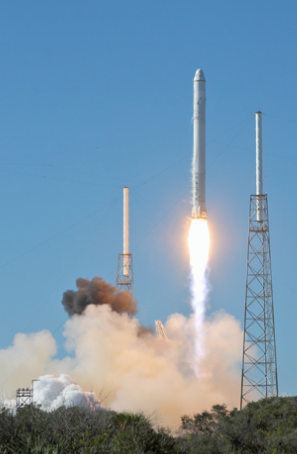
Looks like another delay for SpaceX's Falcon 9's launch at Vandenberg Air Force Base, California. Originally officials announced at the start of the week their plans to aim for a 10:28 a.m. Sunday, January 8 departure, with notices warning boaters and pilots of an upcoming launch and about areas to avoid due to a rocket launch or missile test from the base. Then it was Monday, January 9, however, a further pushout states:
"With high winds and rain in the forecast at Vandenberg Air Force Base, the first launch of 10 Iridium NEXT satellites is now planned for January 14th at 9:54:34 am PST with a back-up date of January 15th."
As SpaceX crews attempted to conduct a countdown rehearsal and engine test firing at Vandenberg the engines ignited before turning off seconds later, while the rocket remains anchored to the launch pad.
On Thursday afternoon, January 5, SpaceX founder Elon Musk announced on Twitter, "Hold-down firing of @SpaceX Falcon 9 at Vandenberg Air Force completed. All systems are go for launch next week." The Falcon rocket will carry 10 Iridium Next satellites, the first set for a second-generation constellation of craft for the satellite-phone system.
The news comes after a four-month-long investigation in which company Chief Executive Elon Musk candidly described in November as “the toughest puzzle to solve that we’ve ever had to solve.” (See Satnews article )

SpaceX Falcon 9
Pending approval from the Federal Aviation Administration, the Hawthorne space company plans to launch 10 satellites on one Falcon 9 rocket for Iridium Communications Inc. from Vandenberg Air Force Base. The satellites will be part of Iridium’s new satellite constellation to provide mobile communications capabilities on land and on ships and airplanes.
On Monday, Iridium tweeted that it was “pleased with SpaceX’s announcement and targeted launch date.”
SpaceX originally speculated that they had hoped to return to flight as soon as November. But as the investigation continued, that anticipated launch date slipped back to December, and then January.
“Clearly, they’re being extra cautious,” said Marco Caceres, senior space analyst for the Teal Group. “SpaceX usually pushes ahead a lot faster, so it seems like they’re not rushing ahead at this point, which is a good thing.”
SpaceX reported viewing 3,000 channels of video and telemetry data that covered 93 milliseconds from the first sign of trouble to the explosion. The company reported that one of three composite overwrapped pressure vessels, or tanks, inside the rocket’s larger, second-stage liquid oxygen tank failed, probably after a buildup of liquid oxygen between the vessel’s aluminum inner liner and its carbon overwrap ignited. The vessels are used to store cold helium that maintains pressure in the liquid oxygen tank. As the liquid oxygen depletes, the helium helps fill the void.
SpaceX said its accident investigation team found “buckles,” or valleys, in the vessel's inner liners as super-chilled liquid oxygen can gather there, and when pressurized, the oxygen can get trapped. Then, “breaking fibers or friction can ignite the oxygen in the overwrap,” causing the vessel to fail, SpaceX said.

